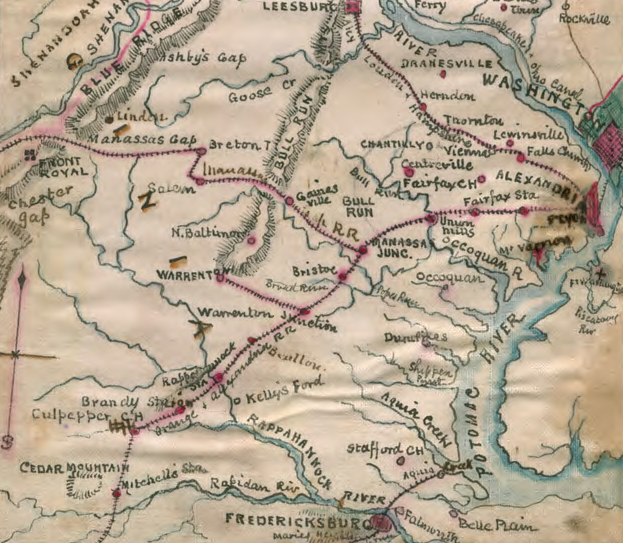
railroads in Northern Virginia at the start of the Civil War
(when there was no direct rail connection between Fredericksburg-Alexandria
Source: Library of Congress, Map of the Potomac River (by Robert Knox Sneden)

railroads in Northern Virginia at the start of the Civil War
(when there was no direct rail connection between Fredericksburg-Alexandria
Source: Library of Congress, Map of the Potomac River (by Robert Knox Sneden)
The locations of the railroads in 1861 determined the location of many of the battles in the Civil War.
The Confederates and the Yankees did not fight at Manassas because the worn-out corn and wheat fields on the banks of a small stream called "Bull Run" were so valuable. The railroad junction was the target, not the territory.
With control over the railroad, the Yankees would be able to supply their army with food and ammunition - and feed the horses hauling artillery and wagons of supplies. Hauling hay for horses in wagons would slow down the Union advance "on to Richmond." Once the Union controlled the rail line through Manassas, however...
The Union Army would be a moving city with a population greater than most Virginia counties - in 1860, only 4 counties had a population greater than 30,000 people. The soldiers were always hungry, and rarely interested in carrying heavy equipment. An amazing amount of "stuff" was issued to the Yankee troops - blankets, cooking utensils, uniforms, tents, weapons, shovels, etc.1
| Virginia County |
1860 Population |
|---|---|
| HENRICO | 61,616 |
| NORFOLK | 36,227 |
| PITTSYLVANIA | 32,104 |
| DINWIDDIE | 30,198 |
After a few miles of walking on a hot summer day, soldiers would pull much of the equipment out of their knapsacks and drop it on the side of the road. After all, lead bullets were as heavy as... lead. Once in camp, or on the eve of battle, the troops would need to be resupplied again.
The generals responsible for the Union Army in 1861 knew that a highway (today's Route 1, paralleled by Interstate 95) connected Washington and Richmond directly. It was the shortest and theoretically the fastest route for the Yankees marching "On to Richmond." That was the rally cry of the Northern newspapers, after Virginia seceded from the Union officially on May 24, 1861 and Richmond became the new Confederate capital.
However, those generals also knew that more than newspaper editorials and soldier courage was important - logistics were essential to military success. For example, the hard-working horses pulling artillery and supply wagons required an extraordinary volume of hay, and it took a lot of horses hauling "fuel" just to feed the horses hauling the cannons and military supplies.
The Virginia farms between Washington and Richmond would not provide hay willingly to a invading Union army matching to take military control of the capital in Richmond and end the Confederacy. Hauling hay and other supplies by rail would make a Union army easier to supply.
Control of the Orange and Alexandria (O&A) Railroad between Alexandria and Gordonsville, and control of the Virginia Central from Gordonsville to Richmond, would make the Union invasion more likely to succeed. The Union generals chose to attack Richmond via the line of the Orange and Alexandria and the Virginia Central railroads in 1861.
It would require traveling more miles to go west to Manassas, south down to Gordonsville, and then southeast to Richmond rather than due south from Washington to Richmond - but the railroads would simplify the logistics dramatically.
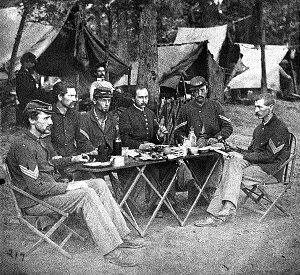
Noncommissioned officers' mess of Co. D, 93d New York Infantry
Source: Library of Congress
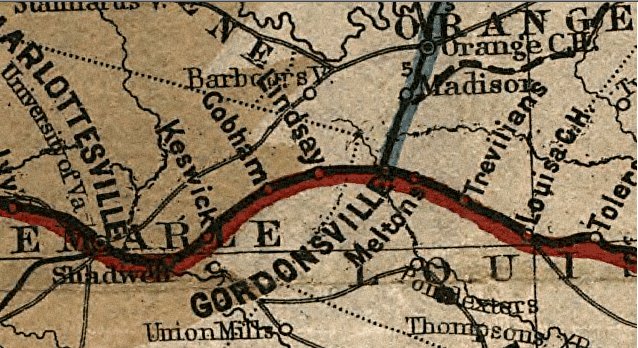
Gordonsville - junction of the Virginia Central RR and the Orange and Alexandria RR
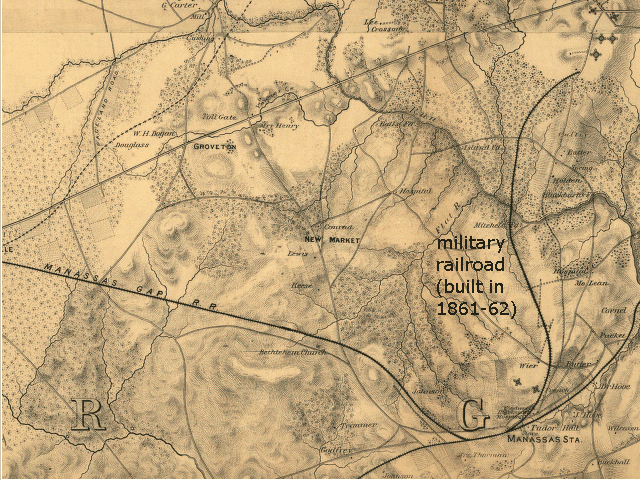
Manassas Junction - and the military railroad built to Centreville between October 1861-February, 1862
Source: Library of Congress, Map of n. eastern Virginia and vicinity of Washington (1862)
Manassas was hardly even a place in 1861. It had a few homes nearby, including Tudor Hall - but it was just a railroad junction, not a town. The junction of the O&A and the Manassas Gap Railroad provided a direct rail connection between the Shenandoah Valley and the Piedmont east of the Blue Ridge - and in war, speed is valuable.
In 1861, the Union was unable to use the Manassas Gap Railroad to move the Federal troops in the Shenandoah Valley to Manassas; the Confederates controlled the territory through which the tracks ran. General Thomas Jackson led the Confederate troops from Winchester, forded the Shenandoah River, spent the night at Ashby Gap (where Route 50 crosses the Blue Ridge today), then walked to Piedmont Station (now known as Delaplane) where the road (modern-day Route 17) and the railroad both crossed Goose Creek.
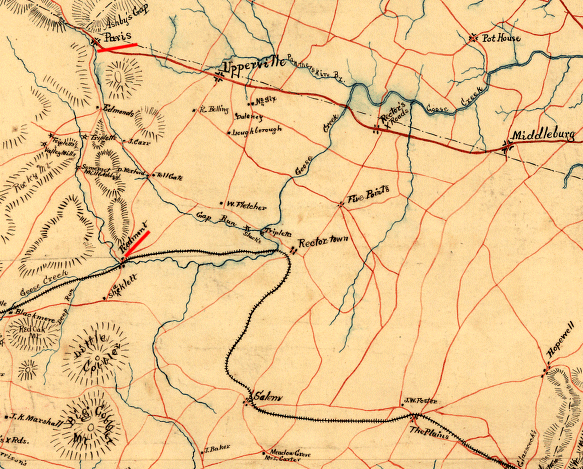
General Jackson's route from Paris to Piedmont Station
Source: Library of Congress
Starting on July 19, 1861, the Confederates loaded General Joseph Johnston's Shenandoah Valley army into boxcars, hauling them 34 miles to Manassas in time to join with Gen. Pierre G. T. Beauregard's army for the major battle there two days later. The Yankees troops at Centreville would have heard the locomotives arrive at Manassas, but the Union forces in the Shenandoah Valley failed to advance and thus force the Confederate reinforcements to return to the valley. The Confederate troops that arrived on Sunday, July 21 during the battle helped determine that the Confederates would win; the major troop movement by train made the difference... and General Thomas Jackson had earned his famous nickname, "Stonewall."2
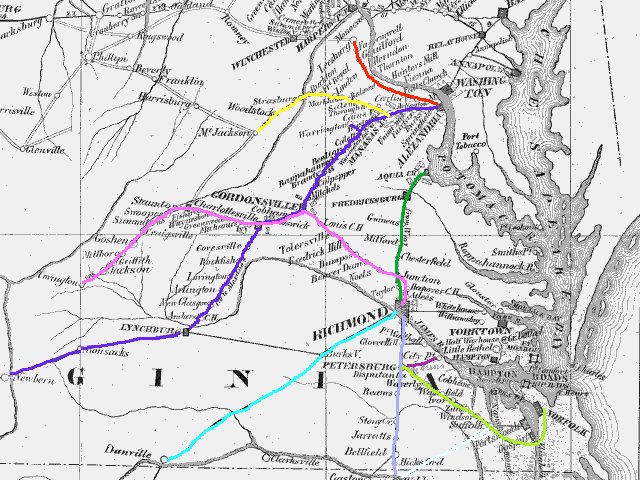
Civil War railroads
Source: Library of Congress - American Memory
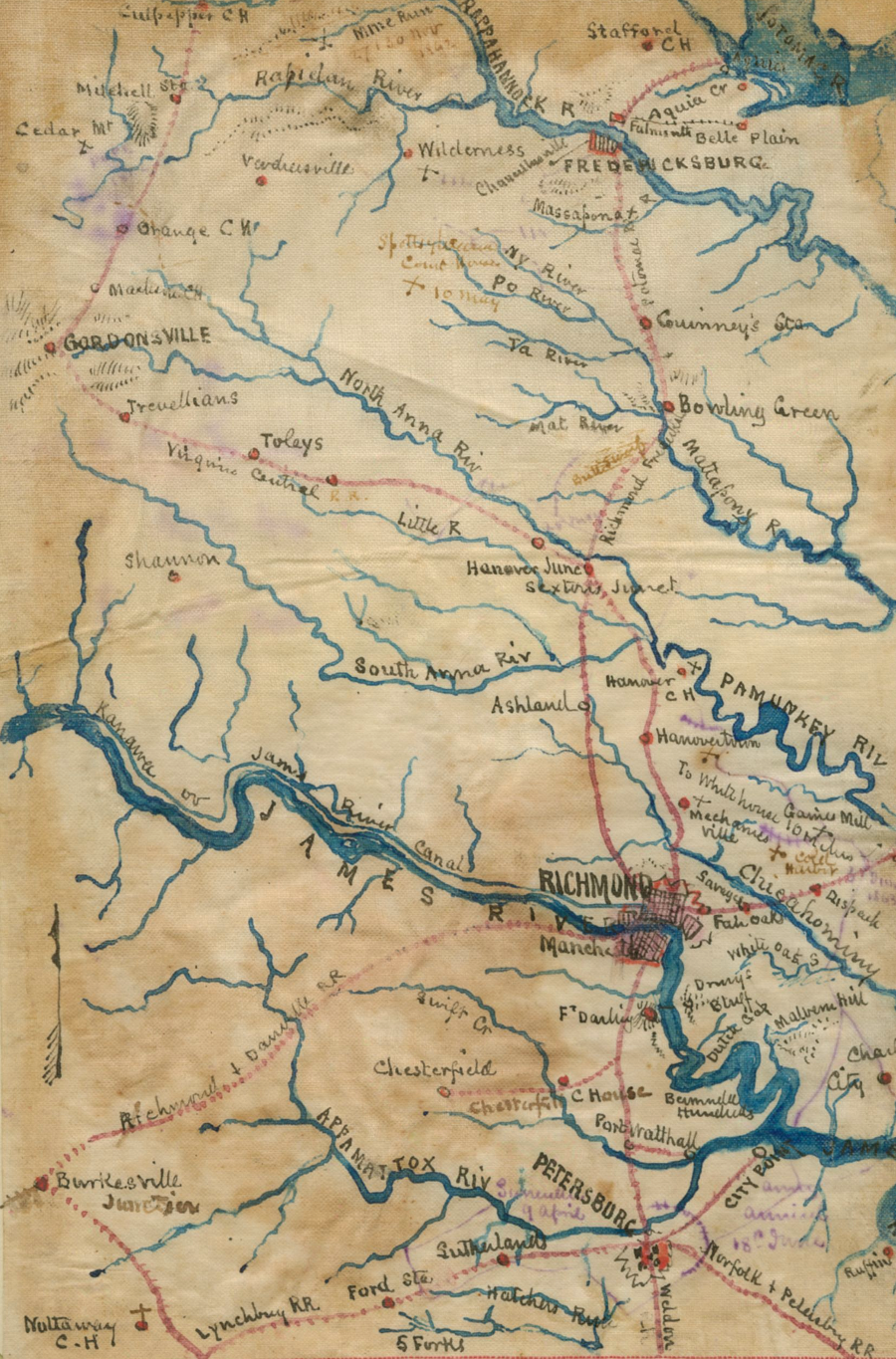
until 1872, the northern end of the Richmond, Fredericksburg, and Potomac (RF&P) Railroad was Aquia Landing on the Potomac River, where steamboats from Washington DC docked
Source: Library of Congress, Fredericksburg to Petersburg, VA (by Robert Knox Sneden, c.1863)
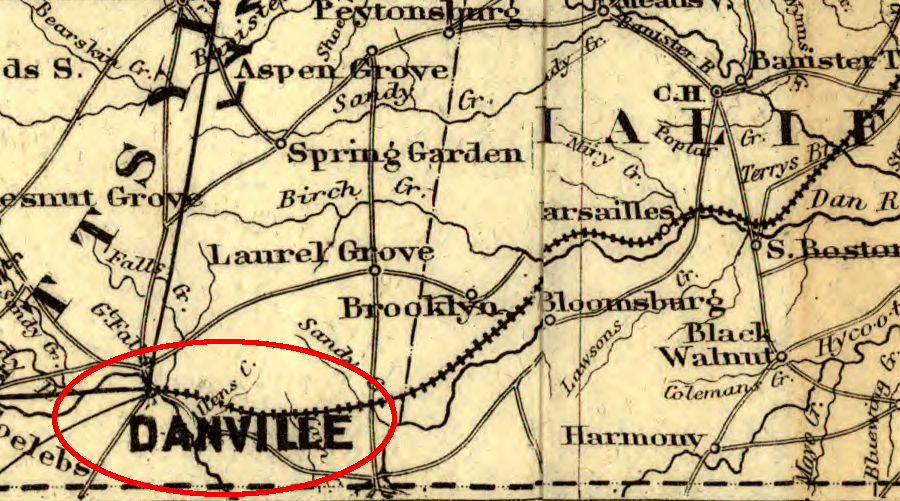
North Carolina blocked extension of the Richmond and Danville Railroad across the border, until the Confederate government mandated construction of the Piedmont Railroad
Source: Library of Congress, Map showing the Fredericksburg & Gordonsville Rail Road of Virginia (1869)
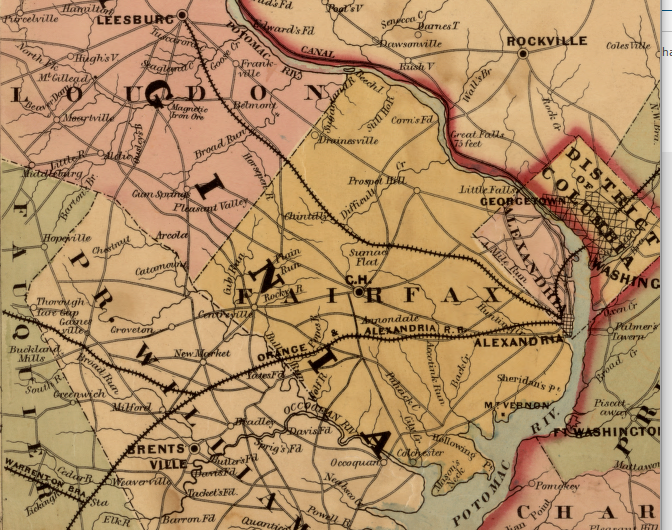
Northern Virginia railroads in 1861
Source: Library of Congress, War map, showing the vicinities of Baltimore & Washington (by G. M. Hopkins, 1861)
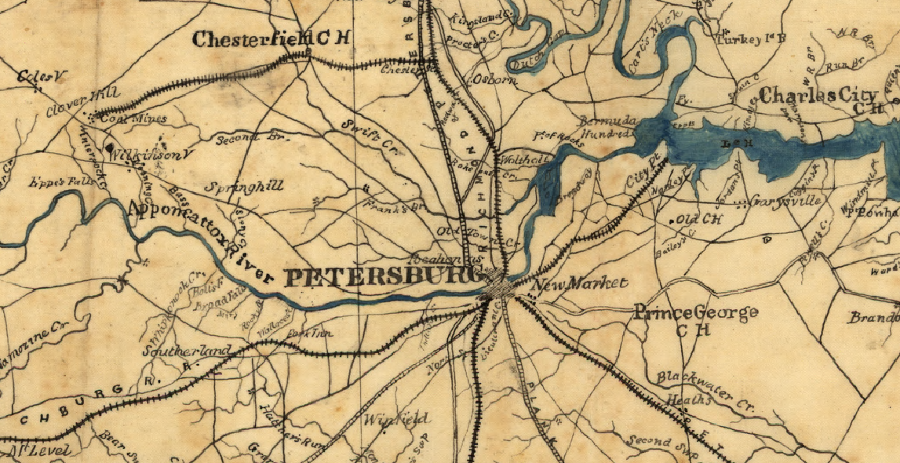
Petersburg was the focal point of railroads that supplied Richmond in the Civil War, making it the primary target for the Union Army in Virginia during the last half of 1864 until April, 1865
Source: Library of Congress, South central Virginia showing lines of transportation (1864)
Source: Gettysburg National Military Park Winter Lecture Series, The War for the Rail Lines in 1864